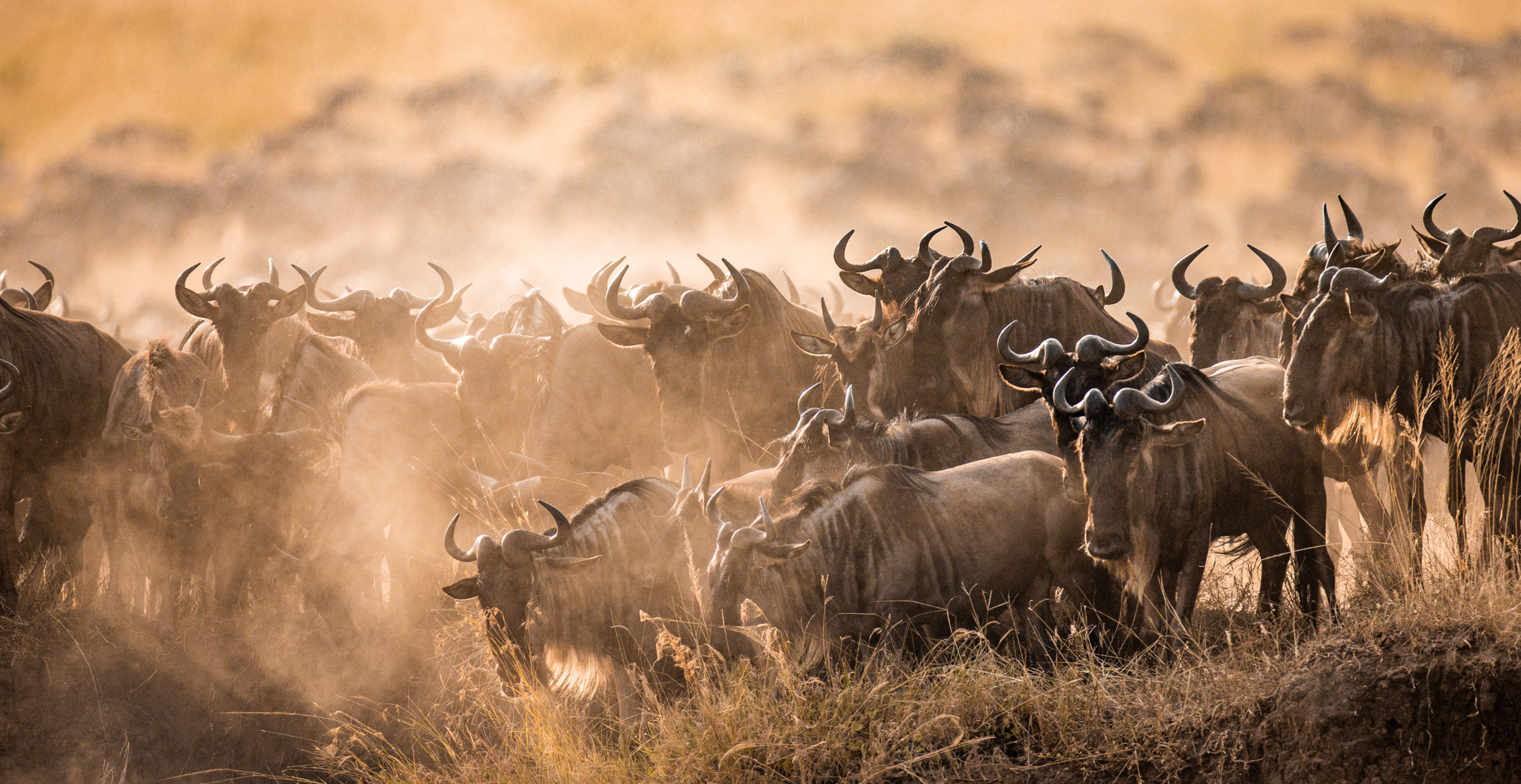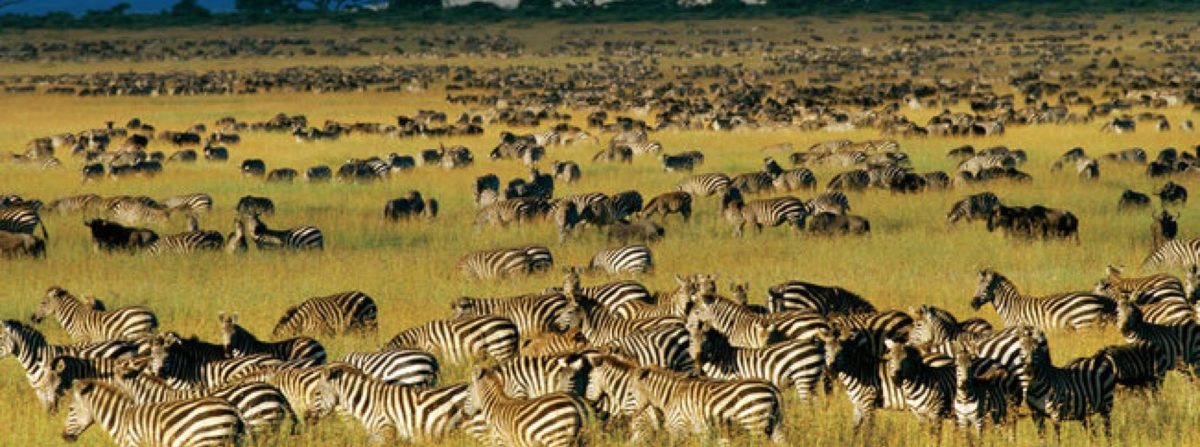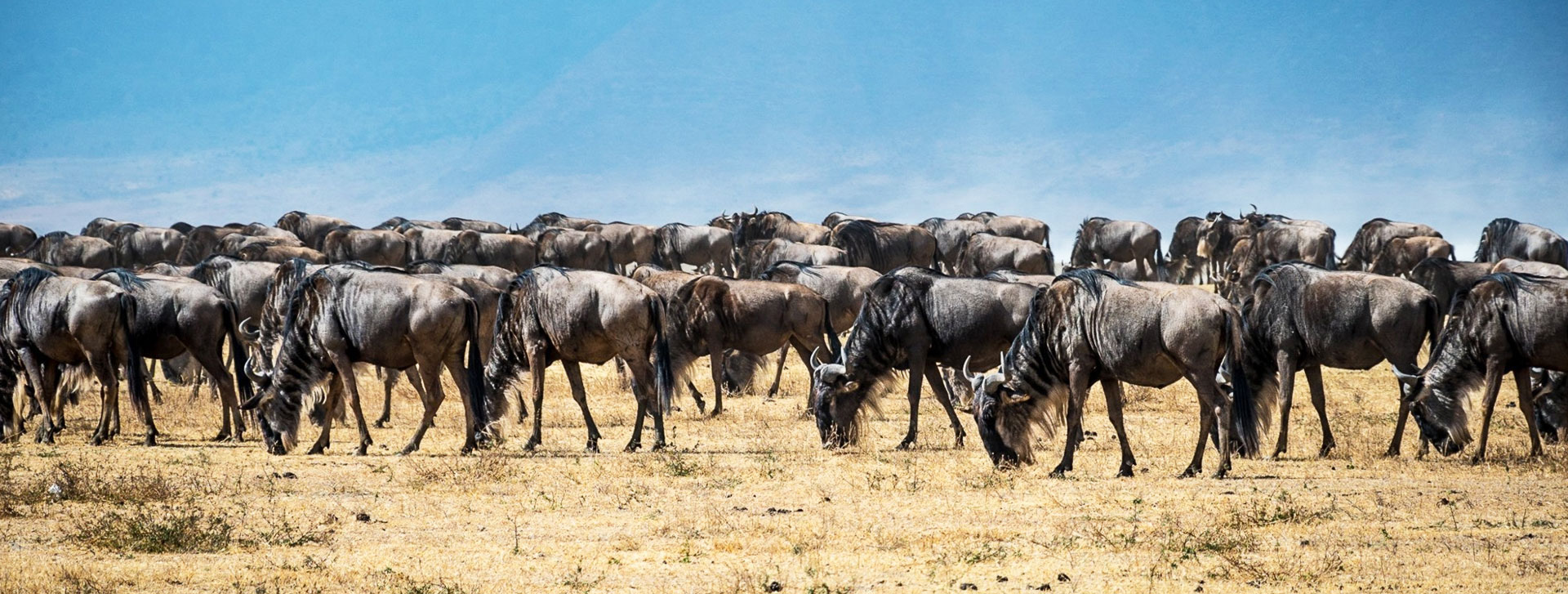The great wildebeest migration is considered among the seven wonders of the natural world. It is the largest overland migration consisting of about 1.5 million wildebeest as well as 20,000 plains game. The black wildebeest (white tailed gnu) and the blue wildebeest (brindled gnu) are the two wildebeest species found in the Serengeti. The blue wildebeest are the ones that migrate and they do so harmoniously with other grazers. This is because they consume different parts of the same grass. This great migration is between the oldest ecosystem on the planet The Serengeti and The Maasai Mara of Kenya. The circuit is about 2,000 miles. About 3000 lions reside in the Serengeti and closely follow behind the herd snatching off the calves and the weak. About 250,000 wildebeests and 30,000 zebras die yearly from exhaustion, thirst, hunger, and predation. Join me as I walk you through every single thing you need to know about the wildebeest migration.
Related: Great Wildebeest Migration Monthly Guide

Where does the migration take place?
The yearly northwest migration kicks off at the south of the Serengeti National park all the way to the Maasai Mara. The herd moves clockwise with most of the migration taking place in Tanzania. The wildebeests pass through: Grumeti Reserve, Loliondo Game Controlled Area, Ngorongoro conservation area, and Serengeti National park. The herd however split up into smaller herds encircling the larger herd due to a lack of leaders.
Is it only wildebeest that migrate?
No, it is not, however, they are the dominant group involved in the migration. The migration is a combination of zebra, Thompson gazelle and Topi not forgetting the wildebeests themselves. The grazers harmoniously travel as they consume various parts of the same grass. Tailing the herd are the various predators in wait for the sick and weak to fall behind so they may have their fill.
 Why do the animals migrate?
Why do the animals migrate?
Wildebeests stay together often in large herds and they tend to consume a lot. Because of this reason, they are constantly moving in search of fresh grass and water. In addition to that, wildebeests consume the top fresh grass leaving behind the rest for their traveling counterparts. As such their migration plays a vital role in their survival.
See: Wildebeest Calving Safari Season
The river crossings
The Mara River is one of the highlights of the great wildebeest migration. The wildebeest have the arduous task of crossing the torrent-filled and crocodile swarmed river. The river Mara lies directly in the path of the migration as it links Kenya and Tanzania. It provides a wondrous view of the sheer strength, power, and agility of wildebeests. The mass bodies and the frantic scramble are truly a sight to behold. The wildebeest get to also cross-river Grumeti which is a highlight of its own.
How can I witness the migration?
You can get to enjoy the great wildebeest migration by visiting east Africa at various points of their migration. There is no wrong time to visit as you pick a time convenient to you. The best camping options include Southern Serengeti’s Asilia migration camp which provides access to Ubuntu, Olakira, and Kimondo migration camps. The best time to visit these camps is between January and March. In the months of April and May, Dunia camp offers spectacular views of wildebeest encircling Moru kopjes. Sayari camps and Asilia mobile migration should be at the top of your list if you’re looking to visit in July. Last but not least Rekero camp is a sight for sore eyes if you’re eager to witness the river crossing.
See Also: Everything you should know about Hot Air Balloon Safari in Serengeti
 January-March Serengeti
January-March Serengeti
This season marks the completion of the herds southward trek as they move across the Serengeti’s eastern edge to the Ngorongoro conservation. While on the Northern slopes of the Ngorongoro crater about half a million wildebeests are born and they join the grazing herd. Since there is no clear end or beginning of their annual circuit, the birthing season is considered the start. Amazingly enough, the wildebeest give birth within the same month.
April/May Serengeti
After the wildebeest have had their fill of the luscious grasslands they proceed to the fresher grass of central Serengeti. Around May, the wildebeest migrate congregating at Mosu Kopjes. The male wildebeest then fight for a chance at mating with the victors securing themselves a spot with the females. As the mating season comes to a close, the wildebeest move in the eastern corridor of the Serengeti.
June /July (Serengeti/Maasai Mara)
June marks the start of the dry season with a great concentration of wildebeests in western Serengeti and southern banks of river Grumeti. The herd can be spotted trailing the western edge towards the north of Serengeti. Some of the wildebeest cross the tumultuous, crocodile-infested river, Mara, where their survival skills are put to the test. They encounter surging currents as well as predators and there is panic and confusion within the herd. Thus some drown, others are eaten by the crocodiles and even those who make it across find other predators awaiting them. In late July the remainder of the migrating herd can be spotted in Maasai Mara.
August-October (Maasai Mara)
Around August, wildebeests are spread across the northern sides of Maasai Mara and the remaining herd on Northern Serengeti. Late September/October the chaos that had previously been in the herd has quieted down. The herd proceeds eastward as they graze thereafter they tackle the turbulent waters of the Mara river on their Southward trail. The smell of November`s short rains triggers the wildebeest to regroup in preparation for their migration.
November/December (Serengeti)
As the short rains of October/November end, it signals the wildebeest to move eastern past the Namiri plains of Serengeti. Cheetahs can be spotted trailing behind the herd in search of an opening to strike. As December approaches, the herd is spread across the southern and eastern reaches. Over this period the Serengeti grass is regularly watered by the rains in preparation for January. The bountiful grass then attracts the wildebeest marking the start of the continuous cycle.
You might also like: Reasons why you should go to Kenya for your wildebeest Migration Safari


